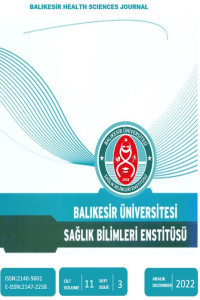Göğüs Hastalıkları Polikliniğine Başvuran Hastaların Elektronik Sigara Kullanımı ile İlgili Tutum ve Davranışları
Sigara, Elektronik sigara, Sosyal medya, Tütün
Electronic Cigarette-Related Attitudes and Behaviors of Patients Presenting to the Pulmonology Clinic
Cigarette, Electronic cigarette, Social media, Tobacco,
___
- Abrams, D. B. (2014). Promise and peril of e-cigarettes: can disruptive technology make cigarettes obsolete? Jama, 311(2), 135-136. doi:10.1001/jama.2013.285347 Breland, A., Soule, E., Lopez, A., Ramoa, C., El-Hellani, A., & Eissenberg, T. (2017). Electronic cigarettes: what are they and what do they do? Ann N Y Acad Sci, 1394(1), 5-30. doi:10.1111/nyas.12977
- Bullen, C., Howe, C., Laugesen, M., McRobbie, H., Parag, V., Williman, J., & Walker, N. (2013). Electronic cigarettes for smoking cessation: a randomised controlled trial. Lancet, 382(9905), 1629-1637. doi:10.1016/s0140-6736(13)61842-5
- Caponnetto, P., Campagna, D., Papale, G., Russo, C., & Polosa, R. (2012). The emerging phenomenon of electronic cigarettes. Expert Rev Respir Med, 6(1), 63-74. doi:10.1586/ers.11.92
- Cheng, T. (2014). Chemical evaluation of electronic cigarettes. Tob Control, 23 Suppl 2, ii11-17. doi:10.1136/tobaccocontrol-2013-051482
- Cullen, K. A., Gentzke, A. S., Sawdey, M. D., Chang, J. T., Anic, G. M., Wang, T. W., . . . King, B. A. (2019). e-Cigarette Use Among Youth in the United States, 2019. Jama. doi:10.1001/jama.2019.18387
- Drummond, M. B., & Upson, D. (2014). Electronic cigarettes. Potential harms and benefits. Ann Am Thorac Soc, 11(2), 236-242. doi:10.1513/AnnalsATS.201311-391FR
- Etter, J. F., Bullen, C., Flouris, A. D., Laugesen, M., & Eissenberg, T. (2011). Electronic nicotine delivery systems: a research agenda. Tob Control, 20(3), 243-248. doi:10.1136/tc.2010.042168
- Farsalinos, K. E., Romagna, G., Tsiapras, D., Kyrzopoulos, S., & Voudris, V. (2014). Characteristics, perceived side effects and benefits of electronic cigarette use: a worldwide survey of more than 19,000 consumers. Int J Environ Res Public Health, 11(4), 4356-4373. doi:10.3390/ijerph110404356
- Flouris, A. D., Chorti, M. S., Poulianiti, K. P., Jamurtas, A. Z., Kostikas, K., Tzatzarakis, M. N., . . . Koutedakis, Y. (2013). Acute impact of active and passive electronic cigarette smoking on serum cotinine and lung function. Inhal Toxicol, 25(2), 91-101. doi:10.3109/08958378.2012.758197
- Goniewicz, M. L., Gupta, R., Lee, Y. H., Reinhardt, S., Kim, S., Kim, B., . . . Sobczak, A. (2015). Nicotine levels in electronic cigarette refill solutions: A comparative analysis of products from the U.S., Korea, and Poland. Int J Drug Policy, 26(6), 583-588. doi:10.1016/j.drugpo.2015.01.020
- Goniewicz, M. L., Knysak, J., Gawron, M., Kosmider, L., Sobczak, A., Kurek, J., . . . Benowitz, N. (2014). Levels of selected carcinogens and toxicants in vapour from electronic cigarettes. Tob Control, 23(2), 133-139. doi:10.1136/tobaccocontrol-2012-050859
- Grana, R., Benowitz, N., & Glantz, S. A. (2014). E-cigarettes: a scientific review. Circulation, 129(19), 1972-1986. doi:10.1161/circulationaha.114.007667
- Harrell, P. T., Simmons, V. N., Correa, J. B., Padhya, T. A., & Brandon, T. H. (2014). Electronic nicotine delivery systems ("e-cigarettes"): review of safety and smoking cessation efficacy. Otolaryngol Head Neck Surg, 151(3), 381-393. doi:10.1177/0194599814536847
- Hitchman, S. C., Brose, L. S., Brown, J., Robson, D., & McNeill, A. (2015). Associations Between E-Cigarette Type, Frequency of Use, and Quitting Smoking: Findings From a Longitudinal Online Panel Survey in Great Britain. Nicotine Tob Res, 17(10), 1187-1194. doi:10.1093/ntr/ntv078
- Javed, F., Kellesarian, S. V., Sundar, I. K., Romanos, G. E., & Rahman, I. (2017). Recent updates on electronic cigarette aerosol and inhaled nicotine effects on periodontal and pulmonary tissues. Oral Dis, 23(8), 1052-1057. doi:10.1111/odi.12652
- Lee, S., Kimm, H., Yun, J. E., & Jee, S. H. (2011). Public health challenges of electronic cigarettes in South Korea. J Prev Med Public Health, 44(6), 235-241. doi:10.3961/jpmph.2011.44.6.235
- Lerner, C. A., Sundar, I. K., Yao, H., Gerloff, J., Ossip, D. J., McIntosh, S., . . . Rahman, I. (2015). Vapors produced by electronic cigarettes and e-juices with flavorings induce toxicity, oxidative stress, and inflammatory response in lung epithelial cells and in mouse lung. PLoS One, 10(2), e0116732. doi:10.1371/journal.pone.0116732
- Lim, H. B., & Kim, S. H. (2014). Inhallation of e-Cigarette Cartridge Solution Aggravates Allergen-induced Airway Inflammation and Hyper-responsiveness in Mice. Toxicol Res, 30(1), 13-18. doi:10.5487/tr.2014.30.1.013
- Pellegrino, R. M., Tinghino, B., Mangiaracina, G., Marani, A., Vitali, M., Protano, C., . . . Cattaruzza, M. S. (2012). Electronic cigarettes: an evaluation of exposure to chemicals and fine particulate matter (PM). Ann Ig, 24(4), 279-288.
- Singh, D., Agusti, A., Anzueto, A., Barnes, P. J., Bourbeau, J., Celli, B. R., . . . Vogelmeier, C. (2019). Global Strategy for the Diagnosis, Management, and Prevention of Chronic Obstructive Lung Disease: the GOLD science committee report 2019. Eur Respir J, 53(5). doi:10.1183/13993003.00164-2019
- Wu, Q., Jiang, D., Minor, M., & Chu, H. W. (2014). Electronic cigarette liquid increases inflammation and virus infection in primary human airway epithelial cells. PLoS One, 9(9), e108342. doi:10.1371/journal.pone.0108342
- ISSN: 2146-9601
- Yayın Aralığı: Yılda 3 Sayı
- Başlangıç: 2012
- Yayıncı: Balıkesir Üniversitesi
Benlik Saygısının Hemşirelerin Mutluluk, Yaşam Doyumu ve Umutsuzluk Düzeylerine Yordayıcı Etkisi
Nurgül ÖZDEMİR, Burçin IŞIK, Burcu ÇAKI
Fertilite Sağlığı Bilgi Ölçeği’nin Türkçeye Uyarlanması: Geçerlik ve Güvenirlik Çalışması
Furkan BİLEK, Caner Feyzi DEMİR
Serap KAYNAK, Yasemin YILDIRIM, Zehra Çiçek FADILOĞLU, Fisun ŞENUZUN AYKAR
Yıldız ERDOĞANOĞLU, Demet SARIYILDIZ
Birsel MOLU, Alev YILDIRIM KESKİN
Merve YUMRUKUZ ŞENEL, Serap DURU, Bahar KURT
Seyhan ÇANKAYA, Cevriye OCAKTAN
Merve Aliye AKYOL, Burcu AKPINAR SÖYLEMEZ, Ecem ÖZGÜL, Özlem KÜÇÜKGÜÇLÜ
